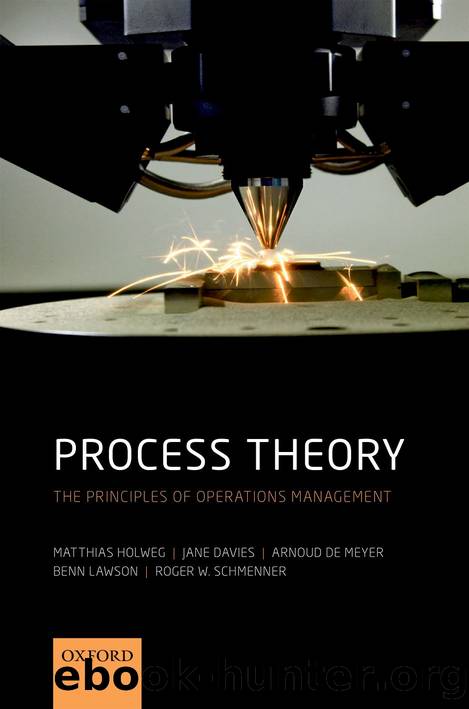Process Theory by unknow

Author:unknow
Language: eng
Format: epub
Publisher: Oxford University Press
Published: 2018-01-22T00:00:00+00:00
One might argue that complexity arising from scale and scope is inevitable for any operation that grows from a start-up to a successful firm. Exposure to complexity is inevitable, but it is the managerial response that determines how the organization performs. Let us consider scale, scope, and the ensuing complexity challenge in more detail.
5.1 The Role of Scale
It is frequently stated that large companies enjoy a competitive edge over small companies because of the inherent advantages of economies of scale. The phrase has a strong appeal, and large companies with sizable operations have a certain aura about them. The phrase draws nods of recognition, yet few people can define it and fewer still have thought critically about it. The original definition of âeconomies of scaleâ discussed four basic scale-related effects, which lead to a reduction in unit cost: (1) if the production volume (throughput) increases, (2) if the capacity utilization increases, (3) when process repetition leads to learning, and (4) when process repetition leads to a reduction in stochastic effects (e.g. defects, breakdowns).1 In short, arguments around economies of scale rest on the assumption that the more that is produced, the better existing fixed costs can be spread across the units produced, and that the more often the process is repeated, the more efficient it becomes. This is the theory.
In practice, however, all too often you hear a company president nonchalantly say something like, âIf we increase the size of our operations here, weâll naturally enjoy some economies of scale.â There is nothing natural about economies of scale, and certainly nothing to be nonchalant about. Confusion about the term is understandable because it serves as an umbrella for a number of real, but quite distinct, concepts. Because it is an umbrella term, âeconomies of scaleâ often loses its usefulness in making management decisions on plant size and capacity.
In fact, the term âeconomies of scaleâ suffers from irredeemable ambiguity. As we have said, it is based on âleversâ that are very different depending on oneâs interpretation of âscaleâ as volume, capacity, or process technology. Even then, there are a variety of ways to effect these economies. Instead of inviting confusion by using the term âeconomies of scale,â we argue that operations managers should think of volume, capacity, and process technology separately. Learning curve effects due to the repetition of the process, in our view, are matters of process improvement and not economies of scale. They are dealt with in Chapter 8.
Moreover, as we will discuss in Section 6.2, there are diseconomies of scale, as well as these economies of volume, capacity, and process technology. With scale come complexity challenges that can escalate. The levels of management can multiply and, with that, control can become more difficult. The ability to be nimble in reaction to competitorsâ initiatives, or even to enact a companyâs own initiatives, can diminish. Logistics becomes more complicated and inventories can balloon. Small can be beautiful and big can be ugly.
But first, we will discuss the three specific types of economies: volume, capacity, and process technology.
Download
This site does not store any files on its server. We only index and link to content provided by other sites. Please contact the content providers to delete copyright contents if any and email us, we'll remove relevant links or contents immediately.
| Automotive | Engineering |
| Transportation |
Whiskies Galore by Ian Buxton(41888)
Introduction to Aircraft Design (Cambridge Aerospace Series) by John P. Fielding(33064)
Small Unmanned Fixed-wing Aircraft Design by Andrew J. Keane Andras Sobester James P. Scanlan & András Sóbester & James P. Scanlan(32744)
Craft Beer for the Homebrewer by Michael Agnew(18146)
Turbulence by E. J. Noyes(7942)
The Complete Stick Figure Physics Tutorials by Allen Sarah(7312)
Kaplan MCAT General Chemistry Review by Kaplan(6868)
The Thirst by Nesbo Jo(6834)
Bad Blood by John Carreyrou(6559)
Modelling of Convective Heat and Mass Transfer in Rotating Flows by Igor V. Shevchuk(6392)
Learning SQL by Alan Beaulieu(6213)
Weapons of Math Destruction by Cathy O'Neil(6152)
Man-made Catastrophes and Risk Information Concealment by Dmitry Chernov & Didier Sornette(5926)
Digital Minimalism by Cal Newport;(5670)
Life 3.0: Being Human in the Age of Artificial Intelligence by Tegmark Max(5479)
iGen by Jean M. Twenge(5368)
Secrets of Antigravity Propulsion: Tesla, UFOs, and Classified Aerospace Technology by Ph.D. Paul A. Laviolette(5311)
Design of Trajectory Optimization Approach for Space Maneuver Vehicle Skip Entry Problems by Runqi Chai & Al Savvaris & Antonios Tsourdos & Senchun Chai(5012)
Pale Blue Dot by Carl Sagan(4917)
